
ONE PLUS ONE EQUALS THREE: The Synergy of Collaborative Cancer Research
When members of the O’Neal Comprehensive Cancer Center investigate complex questions together, the new therapies, discoveries and patient care improvements that result become more than the sum of the parts
By Julie Cole Miller
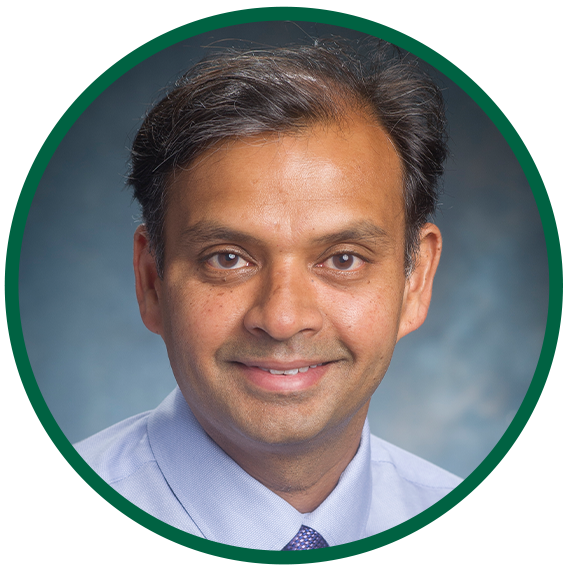
Sunil Sudarshan, M.D.
Senior Scientist, O’Neal Comprehensive Cancer Center
Professor, Department of Urology, UAB Heersink School of Medicine
Anderson Family Endowed Chair
Co-Leader, Cancer Biology & Immunology Program
+
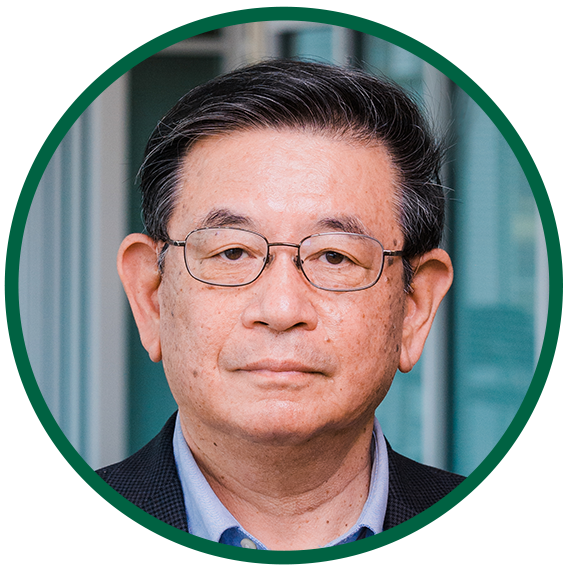
Han-Fei Ding, M.D., Ph.D.
Senior Scientist, O’Neal Comprehensive Cancer Center
Professor, Molecular & Cellular Pathology
Gene P. Seagal Endowed Professor, Department of Pathology, UAB Heersink School of Medicine
=
investigations into new ways to treat neuroblastoma and kidney cancer
“Enthusiasm is contagious,” said Sunil Sudarshan, M.D. “When you have a great collaborator to partner with, it really encourages you to take risks which can lead to new, often unexpected, directions.”
Sudarshan and Han-Fei Ding, M.D., Ph.D., both senior scientists at the O’Neal Comprehensive Cancer Center, joined forces after Ding was recruited to UAB in 2021. Ding is a pioneer in the field of the interaction between gene expression and cellular metabolism, while Sudarshan is a long-time clinician-scientist in the UAB Department of Urology who specializes in both hereditary and sporadic forms of kidney cancer.
When they first met, they knew there was enormous potential to collaborate. They even moved their research labs next to each other so their teams could interact, both formally and informally. Their collaboration involves not only generating and pursuing new lines of study, but also identifying new strategies to treat cancer focused on tumor metabolism.
“The central dogma is that DNA is converted to RNA, which is then converted into protein,” said Sudarshan. “There has been considerable interest in how DNA can be altered to impact gene expression. However, there is clear recognition that RNA itself can also be altered with profound effects on protein expression. This recognition has led to resurgent interest in the field of RNA epigenetics, also referred to as epitranscriptomics. Our laboratories are interested in studying the role of the epitranscriptome in remodeling tumor metabolism.”
Both Sudarshan’s and Ding’s labs tackle malignancies that are not as commonly studied: neuroblastoma and kidney cancer. “Yet, we find clear overlaps with respect to the research questions we are going after and how to go about solving them. This has resulted in each of us bringing unique methodologies and skills to the table and seeing how we can help apply them to the other’s ongoing studies,” Sudarshan said. And on a practical note, “we are also able to better strategize acquiring shared equipment and infrastructure that would benefit both research groups.”
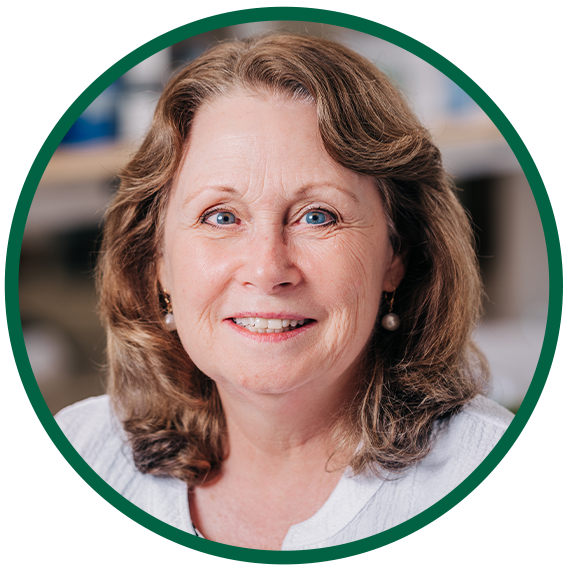
Susan Bellis, Ph.D.
Senior Scientist, O’Neal Comprehensive Cancer Center
Professor, Cell, Developmental and Integrative Biology, UAB Heersink School of Medicine
+
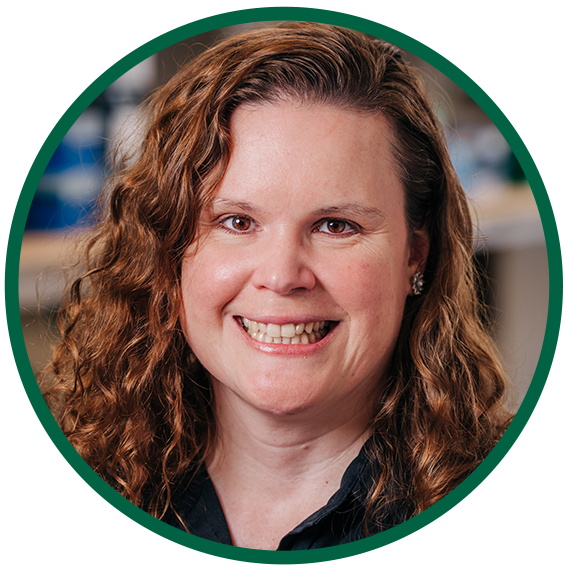
Anita Hjelmeland, Ph.D.
Scientist, O’Neal Comprehensive Cancer Center
Associate Professor, Cell, Developmental and Integrative Biology, UAB Heersink School of Medicine
=
investigations into the role of glycosylation in the cellular behavior of glioblastoma and pancreatic cancer
Senior Scientist Susan Bellis, Ph.D., has been studying ST6GAL1, an enzyme that adds a special sugar structure to glycoproteins, since 1998, when she started her independent laboratory at UAB. Her work has shown that ST6GAL1 expression in cancer cells confers a cancer stem cell phenotype.
As a professor in the Department of Cell, Developmental and Integrative Biology, she was the first to show that the ST6GAL1 protein was upregulated in pancreatic cancer. Years later, she met Anita Hjelmeland, Ph.D., a scientist at the O’Neal Comprehensive Cancer Center and an associate professor in the same department. The two scientists realized they shared a mutual research interest in cancer stem cells.
“We both work on especially lethal cancers, glioblastoma and pancreatic cancer,” said Bellis. “Current treatments for these malignancies are largely ineffective, therefore there is a need to ‘think outside the box’ and attack these cancers from new directions.”
Their collaboration, first supported by a pilot grant for their department, has yielded important findings in how cancer cells behave.
“Our studies with the Hjelmeland laboratory began several years ago when Anita discovered that ST6GAL1 is upregulated in glioblastoma. This was an exciting finding because it implicated ST6GAL1 in cancers other than epithelial malignancies. Anita’s group has since made rapid progress in elucidating ST6GAL1’s role in promoting glioblastoma.”
Both investigators have received funding from the O’Neal Invests program, which enabled the maturation of their work, said Bellis. “These investments in our collaboration have paid off, as we both have NIH funding for ST6GAL1-related projects, as well as many shared publications.” Hjelmeland agreed and shared that the continued reviews from the O’Neal Invests program were helpful for advancing the research and successfully leveraging it for external funding.
Although each researcher has distinct skills and strengths, they both have a strong interest in the fundamental molecular pathways that drive tumor cell behavior. This has been central to their success in elucidating the function of ST6GAL1 in two very different cancers.
“However, the strength of our collaboration is founded on more than our complementary expertise,” said Bellis. “I have treasured working with Anita because I have the highest regard for her as a scientist and colleague. She is a careful and deep-thinking researcher and a generous collaborator.”
Hjelmeland also highlighted the benefit of the collaboration for making these advancements in understanding brain tumors. “Working together allowed us to take advantage of our different areas of expertise and build a research program that neither could do alone,” she said. “Even our very first experiments yielded interesting results that suggested how important ST6GAL1 could be in brain tumors. My students and I have been incredibly fortunate to learn from Susan and her trainees. I am very excited about our continuing collaborative research.”
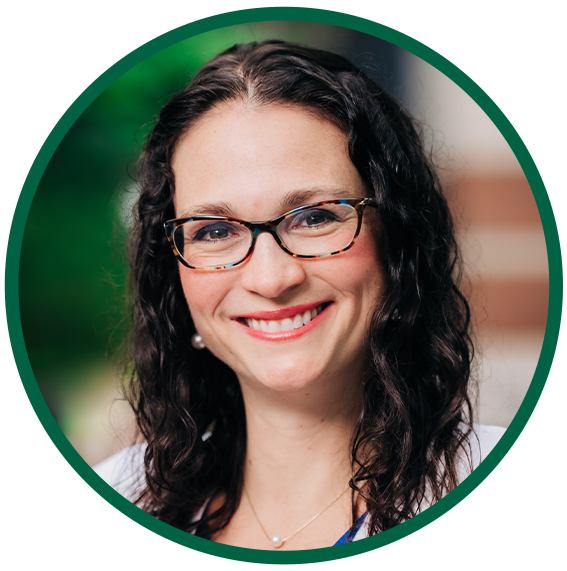
Gabrielle Rocque, M.D., MPH
Scientist, O’Neal Comprehensive Cancer Center
Associate Professor, Hematology & Oncology, Department of Medicine, UAB Heersink School of Medicine
+
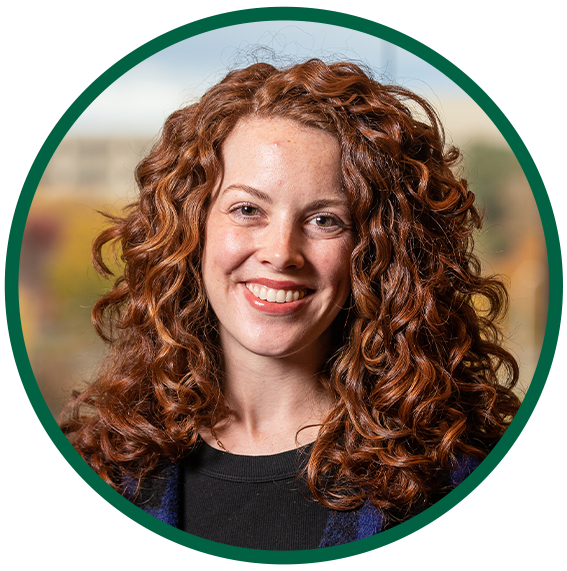
Courtney Williams, DrPH, MPH
Associate Scientist, O’Neal Comprehensive Cancer Center
Assistant Professor, Preventive Medicine, Department of Medicine, UAB Heersink School of Medicine
=
investigations into using electronic patient-reported data to drive improvements in clinical outcomes
Gabrielle Rocque, MD, MPH, is a medical oncologist specializing in breast cancer. Courtney Williams, DrPH, is a health services researcher who studies cancer-related affordability and care access issues. The two together are using data—electronically reported by patients from the comfort of their own homes—to improve care.
For many years, Rocque has served as a mentor to Williams. In fact, their collaboration began in 2015 when Williams worked as a statistician in Rocque’s lab while pursuing her doctorate in Health Care Organization and Policy. When Williams was recruited to UAB in 2022 as an assistant professor, the two joined forces again.
Rocque received a grant to integrate the collection of electronic patient-reported data as part of routine cancer care, and she set out to keep patients out of the hospital by closely monitoring and managing symptoms. The initiative involved receiving and sending text messages to patients’ cell phones to regularly capture symptoms and their severity outside of clinic. Certain feedback would prompt clinic nurses to intervene.
The feedback, however, wasn’t limited to just physical ailments. Williams also saw an opportunity to leverage questions about cancer-related financial hardship.
“Addressing high out-of-pocket treatment costs and their accompanying distress impacts patient outcomes too,” said Williams. “The patient-reported data has shown that about a third of our patients are experiencing cancer-related financial distress, which is even higher for certain patient groups. This data has uncovered a need for financial counselors to help patients address these financial issues. We’re currently in the process of adding these team members to our clinical cancer care teams.”
Their collaboration is changing the landscape for cancer patients at the O’Neal Comprehensive Cancer Center, and now it’s also affecting federal policy initiatives. Their work was invited for presentation at the U.S. Department of Health and Human Services and selected by the U.S. Office of the Assistant Secretary for Planning and Evaluation to inform federal health programs that build data capacity for collecting patient-centered economic data.
“This initiative is cutting-edge—there are very few other institutions routinely collecting patient-reported data to improve the patient-centeredness of cancer care,” said Rocque.
“We’re both interested in addressing larger, systemic issues that affect patient outcomes. Gabrielle is a physician—she brings a lot of clinical expertise, while I’m a scientist specializing in research methods. But we have shared goals. We’re already seeing better outcomes for patients. Patient care is improving in a multifaceted way, and that is really the end goal.”
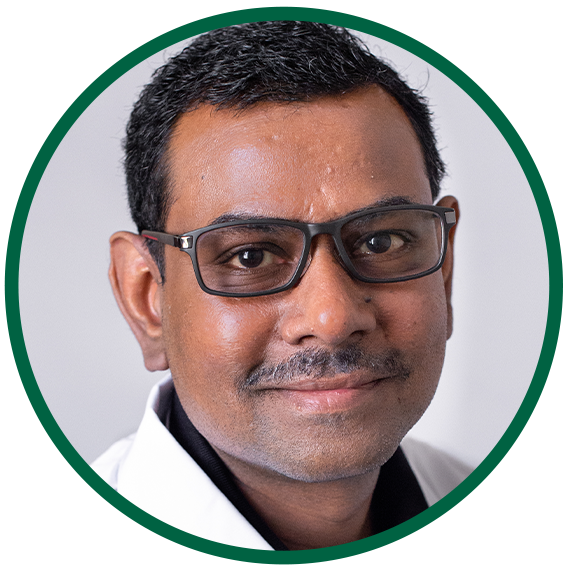
Narendra Wajapeyee, Ph.D.
Senior Scientist and Co-Leader, Experimental Therapeutics Program, O’Neal Comprehensive Cancer Center
Professor, Department of Biochemistry & Molecular Genetics, UAB Heersink School of Medicine
+
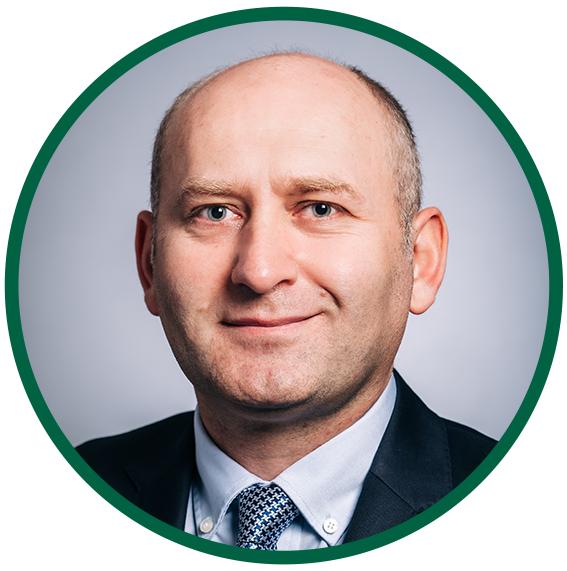
Mehmet Akce, M.D.
Scientist, O’Neal Comprehensive Cancer Center
Associate Director, Hugh Kaul Precision Medicine Institute,
Associate Professor, Hematology & Oncology, Department of Medicine, UAB Heersink School of Medicine
=
clinical investigation of a new combination therapy for liver cancer
Recruited to UAB in 2022, Mehmet Akce, M.D., serves as the leader of the Precision Medicine Working Group and works with faculty to develop a strong portfolio of precision medicine clinical trials for cancer. He is an experienced clinical trialist, and he has led several early phase trials, including molecularly targeted trials. He ensures patients have access to personalized clinical trials evaluating cutting-edge therapies based on known molecular alterations in their tumors.
Narendra Wajapeyee, Ph.D., joined UAB in 2019. Now co-leader of the Experimental Therapeutics Program at the O’Neal Comprehensive Cancer Center, he has investigated a wide range of therapies, in particular those that make use of natural killer cells. His lab identified a new role for the epigenetic modifier enhancer of zeste homology 2 (EZH2) in the regulation of natural killer cells, which complements other studies showing the importance of EZH2 as an immunosuppressive oncogene. This was an important finding.
In light of the novel findings from Wajapeyee’s laboratory and Akce’s expertise in GI oncology, the two scientists developed a clinical trial that aims to combine a novel inhibitor with one of the standard immune checkpoint inhibitor-based therapy approaches.
The preclinical discovery from Wajapeyee’s lab laid the path for clinical exploration of EZH2 pathway inhibition in liver cancer treatment. Akce has developed and led several other innovative investigator-initiated clinical trials, and he brings his expertise in the clinical trials to this project.
“Hepatocellular carcinoma has a dismal five-year survival rate,” said Wajapeyee. “Immune checkpoint inhibitor-based therapy moved to front-line therapy; however, it is active in only a subset of patients. Improving response rate in advanced HCC is an unmet medical need and a combination of novel agents and immune checkpoint inhibitors is an innovative approach.”
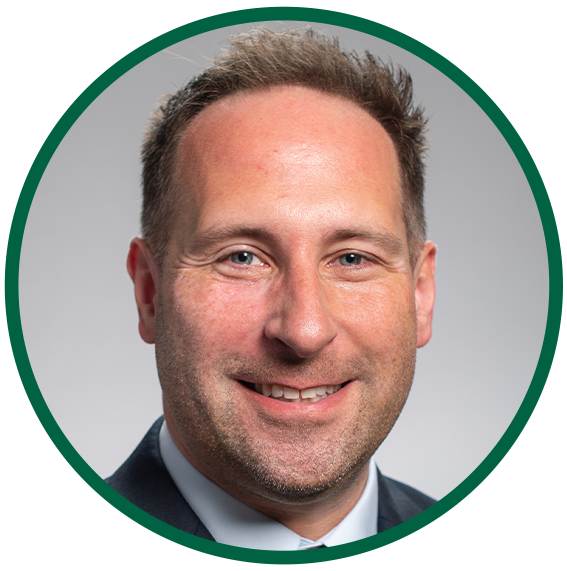
Robert Welner, Ph.D.
Scientist, O’Neal Comprehensive Cancer Center
Associate Professor, Hematology & Oncology, Department of Medicine, UAB Heersink School of Medicine
+
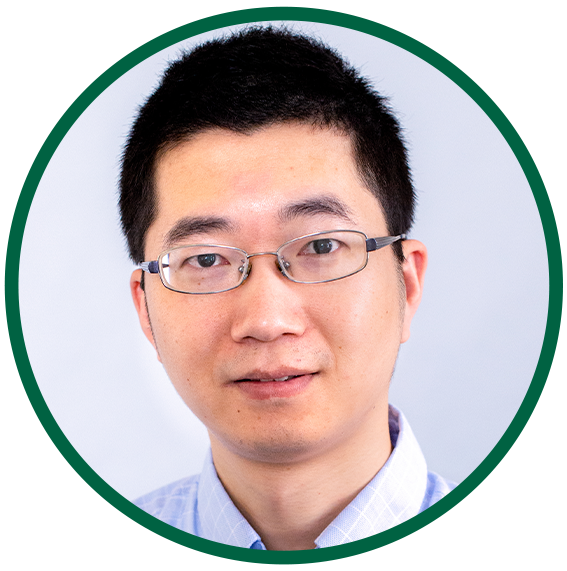
Rui Lu, Ph.D.
Associate Scientist, O’Neal Comprehensive Cancer Center
Assistant Professor, Hematology & Oncology, Department of Medicine, UAB Heersink School of Medicine
=
investigations into improved therapies for leukemia
“Simply put, we’re investigating what goes awry in the development of blood cells, leading to leukemia,” said Rui Lu, Ph.D., of his collaboration with scientist Robert Welner, Ph.D. “Specifically, we focus on clonal hematopoiesis, a condition that occurs with age and can result in an overabundance of mutated blood progenitor cells—a key risk factor for many blood cancers. Using advanced technologies, we analyze how mutated cells behave differently, especially under stressed conditions like inflammation.”
Lu, who has a Ph.D. in Science & Mathematics, Developmental Biology and Embryology, and Welner, who has a Ph.D. in Science & Mathematics, Microbiological Sciences and Immunology—say they are developing new tools and resources that likely wouldn’t happen if they were working alone. They appreciate the opportunity to explore creative ideas by combining their unique skills and expertise, and they challenge each other rigorously along the way.
“As with most successful collaborations, we don’t impede each other’s individual goals or projects, we support them,” said Welner. “We openly share data and resources for a common goal. Our differing backgrounds and methods result in lively discussions of data and viewpoints that push each of us outside our comfortable space.”
Welner and Lu describe their partnership as an intellectual kinship.
Lu has expertise in epigenetic regulation, genome-wide screening and molecular biology, while Welner has a background in immunology, cell biology, inflammation and cell signaling. “We realized that our complementary skills created a unique opportunity to address our shared research questions from multiple perspectives,” said Lu.
“Our collaborative approach gives us a 360-degree view, enabling us to pinpoint how and where the blood development process goes wrong. The aim is to identify precise targets for future therapies.”




